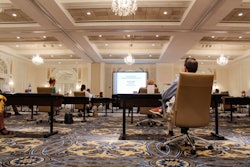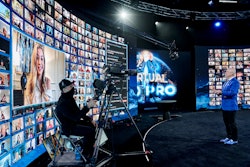
Breakout sessions have always been an important way to keep event attendees enthusiastic and engaged—a task that’s never been more crucial than in a virtual environment, when it may be an attendee’s only chance to turn on their computer cameras and interact with one another. The most effective breakout sessions—whether they’re focused on casual networking, topic-focused education, or accomplishing a designated task—don’t happen by accident. BizBash consulted with experts around the country to learn what works and what doesn’t in this new virtual world.
Do decide if you want to randomize or preselect the breakout groups.
Depending on your desired outcome, the first step is to decide whether to assign or randomize the groups, says Anita Belle, owner and event specialist at New Jersey-based AJB Events LLC. “I find preselecting groups works best to ensure a mix of people, positions, and potential ideas coming from each group. This can also work if you want the same types of people, company, or positions in a group together," she says. "Essentially you can encourage the discussion by creating the group."
On the other hand, Lee Gimpel, founder and principal of Better Meetings in Washington, D.C., prefers to randomize groups using features such as Zoom’s automatic option for breakouts. “The exception to this rule is if you have groups that really want to meet each other, such as buyers and suppliers—suppliers may not find much value in talking with each other,” he points out.
Don't make the group too big.
However you decide to compile the groups, remember to keep them small. This is particularly important in an online environment, where it can be easy for attendees to talk over each other due to connectivity issues. Smaller groups also allow each attendee to feel included and engaged, which can typically be a challenge from behind a screen.
“Just as we never see a giant group of 50 people talking to each other at a roundtable or a reception, big numbers like that don’t work well in online breakouts,” says Gimpel, who thinks that breakout rooms of three to four people typically work best in a virtual environment. “People can easily connect at this size, but they don’t get lost in the shuffle and facelessness of a big group.”
Do test technology ahead of time, and give attendees clear instructions on how it works.
As each virtual platform has its own processes and quirks, don’t expect that attendees will be familiar with the process of entering breakout rooms. “All people learn and process information differently, so I typically provide instructions on how the breakout session will work in four formats: verbally, via a slide on the screen, via the chat box, and as an email link with a PDF containing instructions including the links to and names of the various breakout sessions,” says lifestyle and travel consultant Jackie Omotalade, who regularly teaches virtual courses.
Don't let attendees talk about whatever they want.
Even if the breakout room is meant for casual networking, it’s important to have some sort of designated topic or task to keep it from slipping into casual conversations that may exclude the more introverted attendees. Think through why exactly you added the breakout session to your event, and what you want participants to get out of it.
“Don’t have a breakout session just to fill space on the agenda,” suggests Gloria Pierre, the Toronto-based owner of Clearly Speaking. “Can you use it to strengthen relationships with the participants, introduce them to your business, expand on the topic, answer questions?”
Do have a moderator or some sort of designated leader.
Along the same lines, breakout sessions should appoint a specific person to watch the clock, keep the conversation on track, make sure all objectives are met, and step in if someone is dominating the conversation.
That person can also answer the inevitable technology questions that pop up, notes Tom Winter, co-founder of New York-based tech company DevSkiller, who thinks that breakout groups larger than four should always have a moderator. “Attendees often get confused in breakout rooms,” he points out. “They may take a lot of time to figure out how the tech works, which impacts the event dynamics. To avoid such difficulties a moderator should be there, ready to brief people and facilitate the breakout session.”
Belle, however, thinks that the process doesn’t need to be too formal. “I do not have an assigned facilitator or moderator because the groups often feel as though they are monitored and not having a free discussion,” she explains. “But I do ask each group to self-select a timekeeper and moderator to stay on time and on focus to complete the desired end goal.” She also sometimes has the meeting host pop in and out of small groups to meet people and answer questions.
Don't let anyone fall through the cracks.
In a virtual environment, the breakout sessions may be the only time attendees are speaking and interacting with one another—so it’s crucial to keep them engaged. Build in time for each person to introduce themselves and answer a get-to-know-you question or two to form some immediate group camaraderie.
“The cool thing about these small groups is that everyone has the ability to have their mics and cameras on,” points out Stephan Useche, lead consultant for virtual events at AwA Experiential in Miami. “One great tip I normally give is to create a game where all attendees obtain points for doing certain tasks during the virtual event—e.g., 10 points for turning on the camera, 10 points for setting a virtual background, 10 points for asking one question during the session. This has been proven to increase audience engagement during the sessions.”
Another way to get guests engaged? The old-fashioned ice breaker, of course. For her virtual events, Omotalade likes to get guests moving. “People need to get up and move even if they are at home. We may do jumping jacks, or I may tell everyone to go to their fridge and bring back their favorite drink (and yes, sometimes it is alcohol and that is okay),” she says. “You want people comfortable and engaged.”
Do build in plenty of time.
You may need to add a bit more time than expected to help guests transition to the breakout rooms, get their cameras and mics on, and deal with any unexpected tech issues. Robert Kienzle, senior consultant at online learning company Knowmium, also suggests adding time for small talk, particularly in a virtual setting where people may not have interacted yet. “Be sure to give enough time for this, and even specific timing schedules such as three minutes for introductions and seven minutes for discussion,” he says, adding that transitioning back to the main room also takes time. “And people often take quick breaks when going to or from breakouts to grab water, etcetera.”
On the flip side, don’t go too long with breakout sessions, advises Gimpel. “You can work up to longer periods, but dropping a bunch of strangers in a room for 30 minutes can be asking a lot.”
Don't keep the knowledge and takeaways contained to the small group.
Depending on the type of event, it might make sense to share takeaways with the larger group. “Schedule enough time to debrief and to let breakout rooms share their results,” says Kienzle. “This could be through open conversation, a spokesperson conversation or presentation, in the chat, or on whiteboards.”
Belle agrees. “Report outs after breakout sessions are vital for the shared intellect of a group. Hearing other participants share what occurred in small groups, gathering input from other participants, and being able to ask questions facilitates a genius pool of knowledge and growth,” she says.
Do listen to feedback and adjust as you go.
Not every format will work for every event or audience—and that’s okay. Everyone is learning as they go. It’s a lesson Kristen Parent, the program and events manager for the Middleton Chamber of Commerce in Wisconsin, learned while pivoting the group’s networking events to a virtual environment.The gathering started as a 45-minute session, where everyone was sent to breakout rooms with a facilitator who asked some set questions that were later shared with the larger group.
“It went well, but our group asked us to change it a bit for next time and loosen up on the structure. They wanted it to be more free-flowing,” explains Parent. So for the next event, she eliminated the facilitators and asked the groups to answer some fun, more casual questions. “Once that breakout was done, we brought everyone back and then re-sent them to a new breakout. This allowed them to meet even more people.”
Don't forget that it’s all about human connection.
No matter what your event’s overall goal is, remember that breakout sessions may be the best (or possibly only) way to connect attendees face-to-face. Use the time wisely.







![Hd Gameplay Ff[1][1]](https://img.bizbash.com/files/base/bizbash/bzb/image/2021/04/HD_GAMEPLAY_FF_1__1_.607dd143b9766.png?auto=format%2Ccompress&fit=crop&h=167&q=70&w=250)











